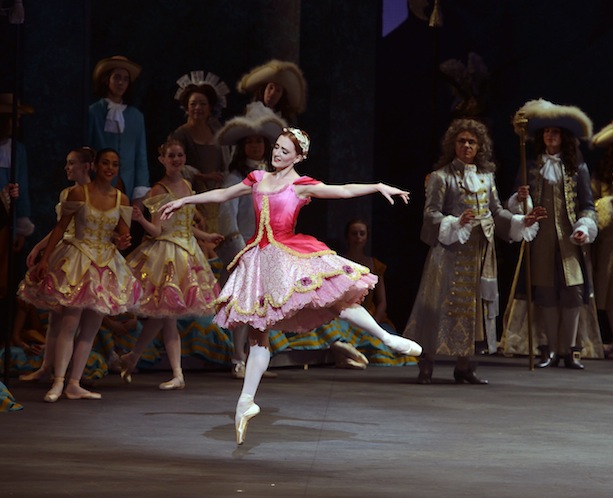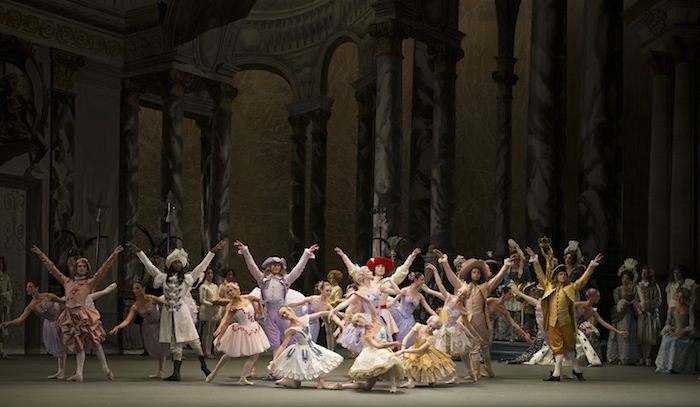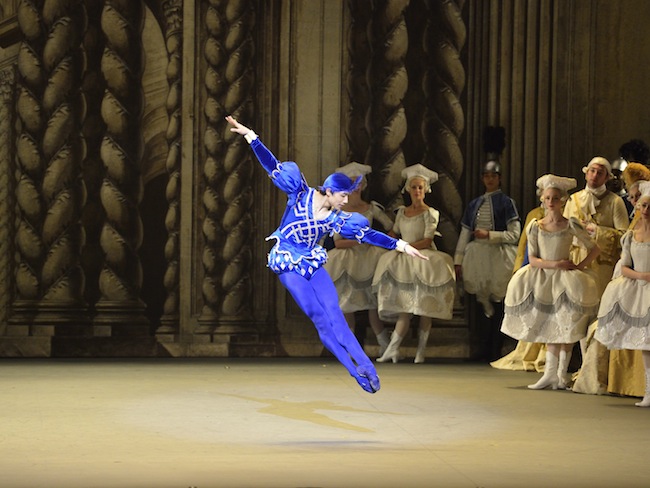Dance Review: American Ballet Theatre’s Eye-Popper of a “Sleeping Beauty”
Few companies can do pageantry quite like ABT, buoyed by its vast resources as well as on this occasion the company’s desire to celebrate its 75th anniversary with panache.
The Sleeping Beauty at American Ballet Theatre, Metropolitan Opera House, New York, June 9,2015

Gillian Murphy as Princess Aurora in the ABT’s production of “The Sleeping Beauty.” Photo: Gen Schiavone.
By Iris Fanger
Although Swan Lake is the universal touchstone for 19th century classical ballet, uniting the choreography of Russian ballet master Marius Petipa with the music of Peter Ilyitch Tchaikovsky, dance enthusiasts have long considered their production of The Sleeping Beauty to be the pinnacle of the genre. Beloved for its celebration of life lived happily ever after (even if it takes 100 years), marveled at for its deft translation of narrative into the language of ballet and mime, and set to one of the most glorious scores in stage history, The Sleeping Beauty has been revived often since its 1890 premiere in St. Petersburg. Later productions have included the 1921 spectacle, renamed The Sleeping Princess, by Diaghilev’s Ballets Russes, the 1939 Sadler’s Wells staging starring Margot Fonteyn, which caused a sensation when the company came to New York on its first tour in 1949, and three productions by American Ballet Theatre, the last in 2007.
Now comes a “new” ABT production of The Sleeping Beauty which premiered in California earlier this year and was unveiled in New York at the Met. (It closed on June 13.) This staging was ‘re-thought’ by the troupe’s Artist in Residence, the Russian choreographer Alexei Ratmansky, with the aid of his wife Tatiana. They mounted the ballet after studying notations of Petipa’s choreography made in 1903 by the Maryiinsky Theater’s ballet master Nicholas Sergeyev, which were based on a system developed in the 1890s by Vladimir Stepanov. Ratmansky’s intention was to strip away the changes that have crept into productions of the ballet over the past century. Richard Hudson’s scenery and costumes—hundreds of them!—were “inspired” by the designs of Leon Bakst, who dressed the dancers and the stage for the Diaghilev production.
The notebooks containing the notations for a number of Petipa ballets were brought into the West by Sergeyev after the Russian Revolution; they have long been housed at the Harvard Theater Collection in Houghton Library. These notations are like musical scores, embellished with diagrams and notes in Russian that cannot be easily deciphered by anyone other than ballet dancers and directors who understand how the ballet must be performed. (E. Virginia Williams, founder of the Boston Ballet, consulted these notations before she mounted her company’s first production in 1977).

A scene from the ABT’s production of “The Sleeping Beauty.” Photo: Gene Schiavone.
Fact is, neither I nor Ratmansky were alive when Petipa was making his ballets, nor were any of the critics who have commented on the production, so it’s impossible to judge whether this version of The Sleeping Beauty is true to the original—or not. Ratmansky instructed his dancers to cycle ballet technique back to more decorous times: when ballerinas slid into arabesques that reached one leg out into space but not up to heaven, and to perform some steps on half-toe rather than on point. The characters speak in mime language more than is customary in contemporary revivals of older works, and the air-borne men have toned down some of the virtuosity that has crept into style since Rudolf Nureyev dared male dancers to follow his lead. Ratmansky has not presented any surprises, but he has staged a ballet that is filled with detailed steps to every measure of the score, highly ornamental gestures, and entrancing arrangements of large groups of dancers. People who have seen the ballet before were not distracted by some unfamiliar additions; viewers new to the work surely had no trouble understanding the action nor marveling at the cascade of picturesque scenes that followed one after another.
At the performance I attended, James Whiteside, a former principal dancer with the Boston Ballet who defected to ABT several seasons ago, was cast as the lead, Prince Desire. Although the Prince has few solo spots, the dancer exuded a dignified presence on stage. Rather than impressing viewers with high flying turns and leaps, he chose to do a perky sort of skimming over the floor. Gillian Murphy, one of the company’s powerhouse principal dancers, was his Princess Aurora, proffering steely balance and meticulously performed footwork, along with a stage charisma of great charm. Craig Salstein turned Carabosse, the evil fairy, into a hip-swiveling character with a sense of humor as well as lust for revenge; Stella Abrera made for an elegant, take-charge Lilac Fairy. Misty Copeland, the soloist who has been much in the news this spring, appeared in the cameo role of Fleur de farine (the Wheat Flower). (Note: the casting of the leading characters changed from performance to performance).
Promising younger members of the company got their moments in the spotlight. In Act III, Cassandra Trenary of the corps de ballet made a striking impression as the Diamond Fairy, as did soloist Sarah Lane (seen earlier in the week as Aurora) as Princess Florine, and Zhiyao Zhang, another member of the corps, as the Bluebird.

Zhiyao Zhang as the Bluebird in the ABT’s production of “The Sleeping Beauty.” Photo: Gene Schiavone.
Few companies can do pageantry quite like ABT, buoyed by its vast resources as well as on this occasion the company’s desire to celebrate its 75th anniversary with panache. Hudson’s period costumes, dating vaguely from the period of Louis XV, and different settings (for the Prologue and each of the three acts) were sumptuous, extravagant, gorgeously colored, and as eye-pleasing a vision as any in my recent memory. To mention one favorite visual: the high-ceilinged Palace of the Prologue that looked like a design by the Bibbienas, the fabled 17th and 18th century family of stage artists. Another amazing sight: the parade of courtiers as they entered the wedding scene with the royal women dressed in ivory and gold, jewel-encrusted gowns with long trains and equally gorgeous costumes for the men.
Unfortunately, the long, cross-country tours of Ballet Theatre, ABT’s predecessor, are a thing of the past. If a fan wants to see a performance by ABT, he/she must travel to California, the Kennedy Center in Washington, DC, or New York for the company’s annual spring season at the Met.
And if Boston Ballet fans want to see Jeffrey Cirio perform in the future, they might have to make the same journey. Unconfirmed rumor has it that he will be the newest member of ABT, joining the company next season. A Boston Ballet spokesperson said only that he “had decided to pursue opportunities elsewhere and we wish him well.” The current ABT season continues at the Met through July 4th with performances of Romeo and Juliet, Swan Lake and Cinderella
Iris Fanger is a theater and dance critic based in Boston. She has written reviews and feature articles for the Boston Herald, Boston Phoenix, Christian Science Monitor, New York Times, and Patriot Ledger as well as for Dance Magazine and Dancing Times (London).
Former director of the Harvard Summer Dance Center, 1977-1995, she has taught at Lesley Graduate School and Tufts University, as well as Harvard and M.I.T. She received the 2005 Dance Champion Award from the Boston Dance Alliance and in 2008, the Outstanding Career Achievement Award from the Graduate School of Arts and Sciences at Tufts. She lectures widely on dance and theater history.
Tagged: American Ballet Theatre, ballet, Boston-Ballet, Jeffrey Cirio, Marius Petipa, Peter Ilyitch Tchaikovsky
